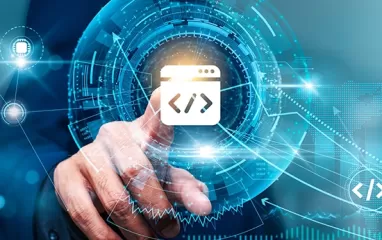Other recent blogs



Let's talk
Reach out, we'd love to hear from you!
The world of IoT is becoming prominent in the digital world as a disruptive innovation that has changed the ways we interact with technology and businesses. This system of smart devices and sensors that can connect to the Internet and each other has expanded rapidly in the recent past, and it is being celebrated as a platform for disruptive innovation within industries.
From home automation, wearable technologies, and health monitoring to industrial applications, smart cities, and manufacturing, IoT’s presence is continuously growing, constantly gathering, and making decisions based on complex data streams. With the Internet of Things on the horizon and interconnectedness becoming more prevalent, the increasing role of IoT is not just a technology trend but a change in adopting connectivity and intelligence in different fields.
Industry analysts predict that the number of Internet of Things (IoT) connected devices will reach more than 25 billion by 2030. Fortune Business Insights predicts the IoT market will grow from $662. 16 billion in 2023 to $3,352. US $97 billion by 2030, with a CAGR of 26 percent.
Surprisingly, this constant increase has positioned IoT as the most relevant technology to support digital transformation programs across industries, significantly reshaping nearly every industry driven by digital innovation.
Navigating the rise of IoT solutions: A broader view
IoT is a broad term encompassing several technologies, applications, and usage scenarios in the context of the Internet of Things concept. IoT devices incorporate technologies that sense, connect, communicate, capture, and discern data.
Gartner's definition of IoT was mentioned as “it is a network of dedicated physical objects (things) that come equipped with embedded technology to interact with their internal states and the outside world; Connecting of assets, process, and personnel enables the capturing of data and event from where business can learn behaviours and usage, act by prevention or improve/enrich business processes; IoT is the lowest layer that helps in building a digital business.” |
In particular, the Internet of Things concerns progressive changes in the fabric of our daily existence and the development of numerous industries. Initially, IoT was just a simple tracking method that utilized only RFID tags to connect objects; however, due to the advancement in technology and the utilization of IPv6 protocol, the IoT involves a set of interconnected devices.
This step toward IoT’s cost-effectiveness and availability started with RFID tags—the small devices that identify objects by using electromagnetic fields without requiring personnel control. At first, they were a method of tracking down their locations using costly equipment; this received a big push with the onset of broadband and wireless networks.
The mass adoption of Internet Protocol version 6 also eliminated barriers to scalability, and the decline of sensors and Internet-linked elements created the potential for IoT. From the industrial and business areas, smart IoT devices are now used in offices and homes as well.

An IoT device functions as a small-scale computer with internet compatibility. It is usually outfitted with processors and sensors that provide the device with data, which is then analyzed using machine learning. In this sense, it can gain insight into users’ actions, respond to their preferences, and provide timely notifications.
IoT solutions lead to an interconnected and intelligent world. Here's how?
IoT solutions drive innovation by integrating artificial intelligence and leveraging data-driven insights across residential and industrial spheres when rooted at the core of a hyper-connected reality. Whether powering smart home capabilities, optimizing manufacturing processes, accelerating digital transformation initiatives, or fortifying global networks, the IoT trajectory fosters an environment of heightened responsiveness and productivity – a symbiosis between human ingenuity and machine cognition.
Here’s how
Reduced costs:
Real-time visibility enables the management to utilize resources and avoid wastage effectively. Thus, companies that understand the exact locations of assets and how they are being utilized can avoid over-purchasing and agree to preventive maintenance, thereby cutting down on maintenance costs and efficiently managing energy. This, in turn, results in effective cost-cutting across operations.
Improved operational efficiency:
Seen in this context, real-time visibility actually helps businesses make improvements where they need to. Businesses can leverage visibility insights to determine where they might hold up and where resources are underused and identify gap areas triggering resource waste. This results in better utilization of resources and time, enabling improved operational efficiency.
Data-driven insights for quick decision-making:
Real-time data affords managers the current position, status and usage of business assets. This means that they can act knowing the outcome or consequences of their actions immediately, not as a reaction to the change or the problem that may be going on. It supports activities related to agile management practices and assists in enhancing business strategies.
End-to-end remote monitoring and management of assets:
IoT is effective in creating awareness and monitoring of assets and resources at a central point. This implies that the managers can monitor and have full control over the physical asset in its different locations without physically having to be there. It is most useful when applied to enterprises that have branch offices or centers or when they must oversee huge premises.
Real-time predictive and prescriptive insights:
Apart from reflecting the current state of a given business landscape, the sophisticated IoT networks alert the user on any emerging weakness or proactively recommend possible future performances or possibly require maintenance based on the historical precedents of the IoT networks as well as the current health statuses of the systems. Also, it provides directive input concerning when and how assets can be best used or how difficulties can be avoided. This way, IoT in asset management supports the goals of avoiding downtime, prolonging the asset’s useful life, and increasing the return on investment.
Improve end-customer experience:
Real-time visibility can directly affect a business's customer satisfaction rate. When IoT devices are deployed at core setups, businesses facilitate IoT visibility through live monitoring and tracking of assets while providing their customers with accurate insights.
For instance:
- In logistics, clients and consignees can always monitor their shipments in real and actual time.
- In services, providers can provide more accurate ETAs and faster response times to customers.
- In manufacturing, work can be done closer to demand and thereby cutting the wait time.
Using real-time data also increases the chances of timely delivery and efficient services to consumers. These, in turn, lead a more responsive, efficient, and customer oriented operation. Real time asset visibility through IoT not only improves the internal operations of a business, but helps the business to respond to the market forces effectively.
Top IoT Uses Cases across industries: The real-life application prisms
At present, there are several areas where IoT solutions add value to their respective business applications. The below section unveils a multitude of real-life applications of IoT technologies across different industries worldwide. Let's have a closer look at the lists of the main IoT use cases, including:

1. Healthcare:
- On-premise patient experience by reducing wait time across emergency rooms or general practice rooms, resulting in significant improvements in revenue and patient experience.
- Patient monitoring/ chronic disease management through monitoring health and wellness activities with the help of fitness trackers, real-time health systems (RTHS), "IoMT" – the Internet of Medical Things, and consumer wearables.
- Independent living experience for elderly patients living alone and suffering from health conditions like dementia. The usage of IoT devices like bed sensors helps in drug management, and GPS sensors help in tracking movement trackers.
- Drug management is also a common real-life application that many healthcare companies rely on to control the amount of drugs used.
- Remote monitoring of medical hardware to predict the medical equipment performance and helps in avoiding replacement cost while improving machine utilization.
- Smart beds in hospital settings help healthcare organizations deliver superior patient experience while collecting actionable health-related information to improve treatments.
2. Smart Utilities:
- Solar/wind energy generation monitoring to identify early the risks of any failure or abnormal decrease in energy efficiency. This lowers potential business disruption risk and optimizes operational excellence.
- Solar/wind control is achieved by tracking the position of panels and turbines installed at the operational location, and it improves power production.
- Water monitoring checks water levels, pressure, turbidity, pH, salinity, ORP, and flow. This helps smart utility companies navigate serious challenges like overflows, conduct real-time tracking of drinking water supply, and monitor the wastewater network along with treatment operations.
- Storage (tanks) monitoring is especially used for oil and gas storage tanks to detect any failure due to manual dependency and improve operational efficiency.
- Electricity pole monitoring is done to keep a check on major tilting of electricity poles, which, if left unattended, may lead to traffic accidents and earth movements.
- Connected meters to identify leaks and breakdowns in real time. Implementation of IoT devices for connect meters also helps automate billing and remotely activate/resume services, which instantly improves customer experience.
3. Manufacturing:
- Asset or fleet tracking is used in supply chain operations to manage raw materials, containers, and finished goods. IoT devices play a pivotal role in optimizing logistics, work in progress, inventory damage, and theft prevention.
- Predictive maintenance by checking the current condition of manufacturing equipment and field devices.
- Remote production control by keeping track of machinery used for production and ensuring maximum safety during automated production while monitoring workers across factory units.
- Connected operations involve identifying performance hurdles in machines and equipment connected to disparate operational data centers. IoT devices connect all the machines and people together through a unified platform and enable connected operational intelligence, which allows for faster problem-area identification.
4. Agriculture:
After the Industrial Revolution in the nineteenth century, automation was adopted and developed to improve its capabilities in achieving complicated transformations and enhancing the level of production. But in the recent past, the agricultural segment has been adopting this trend, with agriculture robots or ‘Agribots’ gaining ground with farmers. This has been occasioned by a general shortage of labor and trends showing an increased demand for food production.
Modern advancements in sensor technology and artificial intelligence have catalyzed the growth of Agribots. These developments allow a machine to learn from its environment and, therefore, can be used anywhere in agriculture. Nevertheless, we have not even entered what may be referred to as the First Age of Agricultural Robotics. Sundry products are now in the trial stages or are still being researched and developed.
Connecting this new area with the general theme of the Internet of Things in agriculture, with the onset and advancement of IoT in farming, more enhancements will be made concerning the application of robotic technology in farming. This technological change is supposed to solve the problems of labor deficit, augment productivity, and perhaps redefine the paradigm for food production.
Some common application areas of IoT devices in Agriculture are
- Weeding robots
These smart agri robots can employ image perception to search their database of weed images for matches to crops and then eliminate them mechanically or using their robotic appendages. With practically all plants developing a resistance to pesticides, this is actually beneficial to the environment and to those who earlier sprayed pesticides all over the farm.
- Machine navigation
Just as toy cars can be controlled with a controller, tractors and heavy plowing equipment can work with GPS from home. These integrated automatic machines are very accurate, and they can self-regulate depending on the type of terrain, which consequently eases some of the time-consuming exercises.
- Harvesting robotics
Using robots for picking crops addresses the issue of a worker shortage. These new-generation machines can work around the clock and carry out the very sensitive operation of harvesting fruits and other vegetables.
These machines integrate image processing and robotic arms to identify the fruits for picking and regulate their quality. The high operational costs are due to the early devoted agribot harvesting of contents that include orchard fruits such as apples.
These bots can be used for greenhouse harvesting and are applicable to high-value crops such as tomatoes and strawberries. They can be deployed in greenhouses to better differentiate crops' status and pick them when they are overdue.
- Drones in agriculture
To enhance and optimize various farming activities such as crop monitoring, crop spraying, soil analysis, and mapping. In fact, agriculture is one of the major sectors to incorporate drones. Drones equipped with sensors and cameras are used for imaging, mapping, and surveying farms. There are ground-based drones and aerial drones. Ground drones are bots that survey the fields on wheels. Aerial drones are flying robots, formally known as unmanned aerial vehicles (UAVs) or unmanned aircraft systems (UAS).
5. Retail
- Automated checkout through connected POS machines and terminals streamlines the overall checkout shopping process. IoT makes traditional stores smart via shelf sensors, connected cameras, and AI, resulting in significant improvements in the shopper's experience and staff efficiency.
- In-store layout for shopper experience optimization by leveraging real-time shopper movement data captured by IoT devices through smart sensors, connected cameras, and AI.
- Predictive equipment maintenance in real time is a game-changer in preventing issues like malfunctioning, managing waste, and avoiding reputational/monetary losses.
- Inventory management/optimization is achieved by using connected vending machines, automating packaging services, predicting inventory shrinkage, and improving store efficiency.
Experience hyperconnected and smart IoT ecosystem with Kellton
Supercharge your business performance faster with Internet of Things and deliver relevant consumer experiences at scale with Kellton. We accelerate your transformation journey through next-level IoT solutions powered by future-focused technologies like Data Analytics, AI, and Cloud. From IoT application development to system integration, and platform development, we ensure a 360-degree customer-first transformation by leverage our alliance partners, technology advances, right methodologies, and secured ecosystem to deliver increased productivity and speed your products to market.



